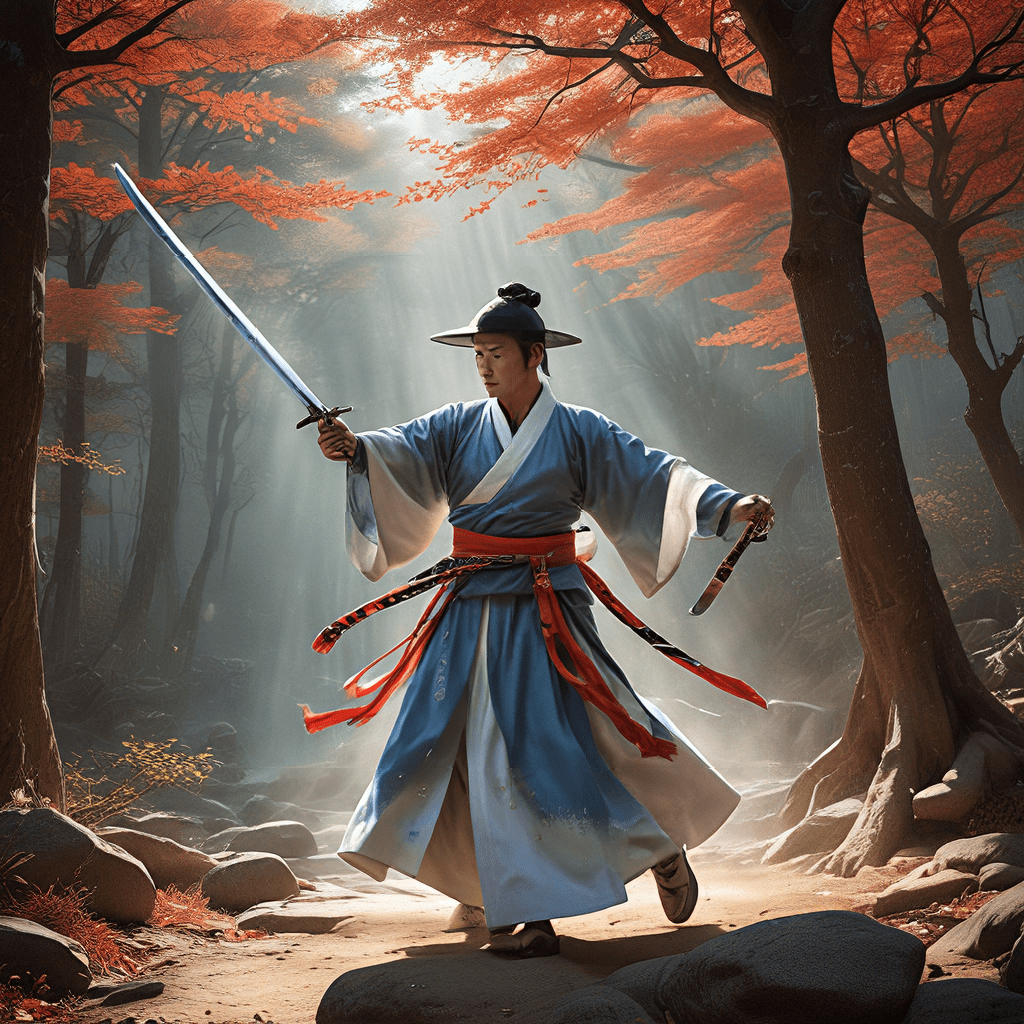The Divine Sword of Geumgangsan: A Mythical Artifact in Korean Folklore
In the realm of Korean folklore, where ancient myths and legends intertwine with history, there exists a powerful and mystical artifact: the Divine Sword of Geumgangsan. This legendary sword, steeped in tales of divine intervention and heroic deeds, has captivated the imagination of Koreans for centuries. Its story resonates with themes of power, authority, and national identity, revealing a fascinating glimpse into the cultural fabric of Korea.
The Power and Legend of the Geumgangsan Sword
The Geumgangsan Sword, also known as the "Sword of the Diamond Mountain," holds immense power and is believed to be imbued with divine energy. Legends surrounding the sword depict it as a celestial weapon forged by the gods themselves. It possesses the ability to vanquish evil, bring prosperity, and protect the land from harm. The sword's formidable strength is said to derive from the sacred mountain from which it originates: Geumgangsan, a towering peak revered as a symbol of Korean spirituality and national pride.
The Sword’s Role in Korean Mythology and History
The Geumgangsan Sword plays a significant role in various Korean myths and legends, often appearing as a symbol of divine favor and a powerful tool used by heroes. One popular tale tells of a legendary warrior who wielded the sword to defeat a monstrous creature threatening the kingdom. Another story recounts how the sword granted its possessor the power to unite the land and establish a prosperous dynasty. These narratives solidify the sword's status as a vital element in shaping Korean mythology and history.
Geumgangsan: Sacred Mountain and Source of Legend
Geumgangsan, the Diamond Mountain, is a towering and majestic peak located in the north of the Korean Peninsula. This sacred mountain holds immense spiritual significance in Korean culture and has been a source of inspiration for countless myths and legends. The name "Geumgangsan" translates to "Diamond Mountain," reflecting the mountain's rugged and unyielding nature. Its breathtaking landscape and towering peaks have inspired awe and reverence for centuries, making it a fitting location for the creation of the legendary Geumgangsan Sword.
Depictions of the Sword in Korean Art and Literature
The Divine Sword of Geumgangsan has been a recurring motif in Korean art and literature, serving as a powerful symbol of power, authority, and national identity. Depictions of the sword often feature intricate details, with its handle and blade adorned with intricate carvings and inscriptions. The sword has been featured in various forms of Korean art, including paintings, sculptures, and ceramics. Its enduring presence in Korean art and literature attests to its deep cultural significance and the enduring power of its legend.
The Sword as a Symbol of Power and Authority
The Divine Sword of Geumgangsan is much more than a physical weapon in Korean folklore. It's a powerful symbol representing authority and leadership. The sword's ability to vanquish evil and bring prosperity links it directly to the ruler's responsibility to protect and guide the people. In many tales, a worthy ruler inherits the sword, demonstrating their divine right to rule and their commitment to justice and good governance. The sword's presence in the hands of a leader signifies their power, authority, and divine blessing.
The Geumgangsan Sword’s Connection to Korean National Identity
The Geumgangsan Sword isn't just a symbol of power; it's also deeply intertwined with Korean national identity. The sword's origins, forged from the sacred mountain Geumgangsan, symbolize the strength and resilience of the Korean people. Tales of the sword often feature heroes protecting Korea from invaders or overcoming challenges that threaten the country's well-being. These stories reinforce the idea that the sword embodies the spirit of Korea, its determination to persevere, and its commitment to protecting its land and people.
Theories on the Origin and Purpose of the Sword
While the Divine Sword of Geumgangsan is a mythical artifact, its existence in folklore suggests its roots in real-world beliefs and practices. Some scholars theorize that the sword might be based on a real, powerful object, possibly a ceremonial weapon or a symbol of royal authority. The sword's association with the sacred mountain Geumgangsan suggests a connection to shamanistic beliefs and the worship of mountain spirits. These beliefs might have influenced the creation of the legend and its significance in Korean folklore.
Possible Historical Influences and Interpretations
The presence of the Geumgangsan Sword in Korean folklore might reflect historical events and societal structures. The sword's power to unite the land and establish a prosperous dynasty could be interpreted as a reflection of the desire for a strong and unified Korean kingdom. The sword's role in protecting against threats could be linked to the historical challenges faced by Korea, such as invasions or natural disasters. Analyzing these historical influences provides a deeper understanding of the sword's symbolic meaning and its cultural significance.
The Enduring Legacy of the Geumgangsan Sword in Korean Culture
The Divine Sword of Geumgangsan remains a powerful symbol in Korean culture, even today. Its image appears in contemporary art, literature, and media, often representing strength, resilience, and national pride. The sword's enduring presence in Korean folklore speaks to its ability to resonate with diverse audiences across generations. By exploring the legend of the Geumgangsan Sword, we gain a deeper appreciation for Korean mythology, history, and the enduring power of stories to connect us to our cultural heritage.
FAQ
Q: What is the Geumgangsan Sword?
A: The Geumgangsan Sword is a mythical artifact, a divine weapon in Korean folklore, said to be forged by the gods and imbued with immense power.
Q: What is the Geumgangsan Sword's significance in Korean folklore?
A: The sword is a powerful symbol of authority, strength, and national identity, appearing in many myths and legends.
Q: Is the Geumgangsan Sword a real object?
A: The sword is a mythical artifact, but its existence in folklore suggests it might be based on a real, powerful object, possibly a ceremonial weapon or a symbol of royal authority.
Q: How does the Geumgangsan Sword connect to Korean national identity?
A: The sword’s origins in the sacred mountain Geumgangsan, symbolize the strength and resilience of the Korean people. It's often featured in tales where heroes protect Korea from threats, reinforcing the idea that the sword embodies the spirit of Korea.
Q: Why is the Geumgangsan Sword still relevant today?
A: The sword remains a powerful symbol in Korean culture, representing resilience and national pride. It continues to appear in contemporary art, literature, and media, showcasing its enduring cultural importance.



